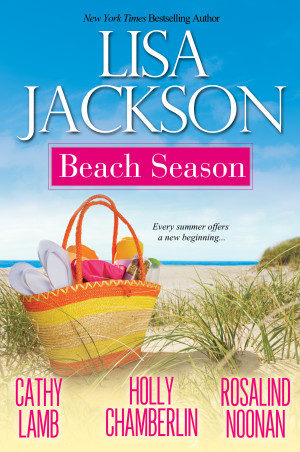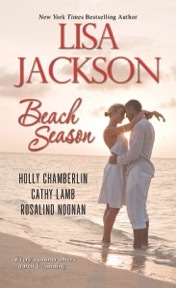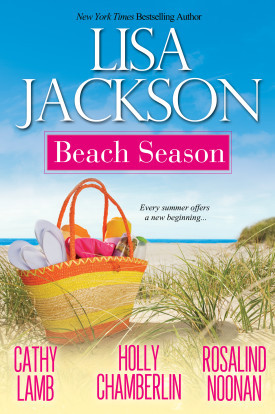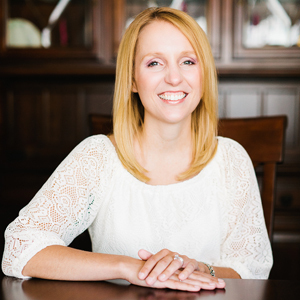Cathy Lamb's Blog, page 54
June 15, 2015
The Ladies Of Beach Season
Hello everyone!
Wishing you a romantic beach vacation this summer. Sun. Surf. Coffee. Chocolates. And, an excellent beach read.
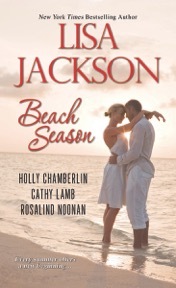 Can I suggest four short stories in our anthology, Beach Season? This anthology is being re – released, back for ladies who like to read on the beach while sipping mimosas and eating brownies. What? Mimosas and brownies don’t sound good together?
Can I suggest four short stories in our anthology, Beach Season? This anthology is being re – released, back for ladies who like to read on the beach while sipping mimosas and eating brownies. What? Mimosas and brownies don’t sound good together?
The four authors of Beach Season, Lisa Jackson, Holly Chamberlin, Rosalind Noonan, and myself are interviewed below.
Yes, I interviewed myself. It was an odd experience, but one I’ve done before. I ask a question, then I answer it. Not unlike how I write my books. I hear voices, I write down what they’re saying.
Anyhow, happy summer to all of you. We hope you enjoy Beach Season – the book, and the sandy beach.
Lisa Jackson
Cathy Lamb: Describe the best day you ever had at the beach.
Lisa Jackson: I live part time at the beach and I have so many great days. Especially with the dogs. Once my little pug, Jackie O No, jumped into a deep tide pool as I was taking a picture of a starfish on a rock. I had to drag her out of the frigid water and walk her over two miles back to the house.
Another time my girlfriend and I were walking and Bonzi, my son’s rescue pitbull, was galloping beside us. A little girl and her father, each on a horse, came racing by, chasing him and actually tried to lasso him like a calf in a rodeo! They requested my help and I flipped out. They thought Bonzi belonged to someone a couple of miles down the beach and I emphatically assured them he was my dog! They left, but Bonzi never trusted a horse again!
 Tell us about your story in Beach Season
Tell us about your story in Beach Season
My story in BEACH SEASON is THE BRASS RING, and it’s a book I wrote a few years back. It’s the story of Shawna and Parker, about to be married and it seems, to catch the brass ring of life. However things are never as they seem. Tragedy strikes and the couple has to struggle to reconnect.
What are three things you love about being a writer and three things that are a challenge?
Writing the book is a thrill and a challenge. Writer’s block, looming deadlines and real life get in the way, but how much fun is it to create characters and a story around them? I have to admit, I love to write in the winter, but when the summer sun appears, I have a more difficult time staying inside with the characters I’ve created.
What are the plusses of writing a short story versus a novel? I prefer writing a novel. I just need the time to develop the character’s plotline and subplot. I love to fill a town with characters. A short story is pretty condensed for me.
What do you like about writing romantic scenes, or creating romantic tension, in your books?
I only like to write romantic scenes if there’s a lot of tension involved so that’s what I work on, the tension within the romance, the reason these people can NOT fall in love; otherwise, for me, the scenes fall flat. So the more reasons they shouldn’t be together, the more angst of them aching to be together but knowing it’s a mistake works for me.
You can find out more about my books at www.lisajackson.com
Thank you, Lisa! Wishing you lovely days at the beach this summer!
Holly Chamberlin
Cathy Lamb: Describe the best day you ever had at the beach.
Holly Chamberlin: My best ever day at the beach? That’s a tough one but I can say that just yesterday my husband, Stephen, and I walked Scarborough Beach at mid-tide against an extremely strong and cold wind. We had the beach pretty much to ourselves, except for a few piping plovers, and it was just beautiful. That’s how I like the beach best, empty of other people and with sand scooting along in ghost fingers created by the wind.
Tell us about your story in Beach Season.
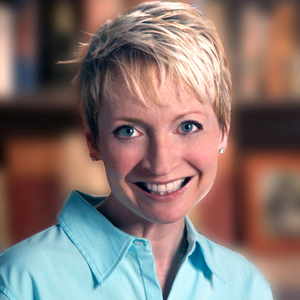 My story in this collection is called “Second Chance Sweethearts”. The heroine, Thea Foss, was separated from her first and greatest love, Hugh Landry, back when they were in college, due to circumstances beyond their control. Now in their mid-thirties, Thea and Hugh unexpectedly bump into each other one fine summer day. Thea is recovering from a disastrous marriage to a crook and an abuser, and Hugh is the survivor of a bad accident and a broken engagement. The big question for these star-crossed lovers is: Can a new reality ever equal the perfection of a remembered past?
My story in this collection is called “Second Chance Sweethearts”. The heroine, Thea Foss, was separated from her first and greatest love, Hugh Landry, back when they were in college, due to circumstances beyond their control. Now in their mid-thirties, Thea and Hugh unexpectedly bump into each other one fine summer day. Thea is recovering from a disastrous marriage to a crook and an abuser, and Hugh is the survivor of a bad accident and a broken engagement. The big question for these star-crossed lovers is: Can a new reality ever equal the perfection of a remembered past?
What are three things you love about being a writer and three things that are a challenge?
Three things I love about being a writer? That’s another difficult question to answer because being a writer is just what I have to be. The deal is that I’m pretty useless otherwise! Still, there are plenty of challenges. One of the biggest is not succumbing to despair when the ideas aren’t forming and the words aren’t flowing. You have to learn how to keep soldiering on – not an easy lesson! – and trust that your sluggish creative mind will indeed wake up before your next deadline.
What do you like about writing romantic scenes, or creating romantic tension, in your books?
For me, writing a short story or a novella is far more challenging than writing a full-length novel. I can’t even read a short story without palpitations! I’m far more comfortable with the expanse of a novel. Maybe because given my particular strengths and weaknesses, packing a serious emotional punch takes more time and space than a novella allows.
What do you like about writing romantic scenes, or creating romantic tension, in your books? Honestly, I hate writing sex scenes and have to be prodded none too gently by my editor to do so! I enjoy, however, creating romantic tension, as long as there’s a playfulness to it. Verbal sparring is fun. I leave the real romance writing to the experts!
Thank you, Holly! Have a wonderful summer. I hope you get long, lazy reading and writing days at the beach!
Visit with Holly here: http://www.hollychamberlin.com/
Rosalind Noonan
Cathy Lamb: Describe the best day you ever had at the beach.
Rosalind Noonan: Ocean City, Maryland, some July day in 1970. The waves were cresting just over our heads, making a perfect curl for body surfing or using rafts to ride in on a clean line. And when we took a break from the ocean, we crossed the sand to the boardwalk for thick slices of pizza, cheese bubbling. And caramel corn. And boardwalk fries. And cool shops. Back then the beach boutiques had purple peace signs, hippie beads and psychedelic posters. I can still hear Neil Young singing “Ohio.” It was quite an era.
Tell us about your story in Beach Season
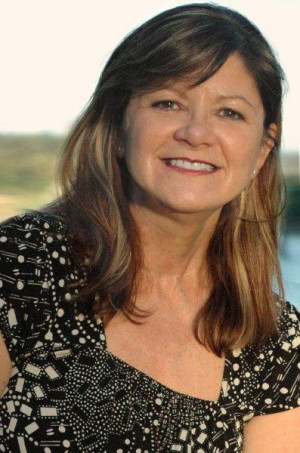 CAROLINA SUMMER is the story of Jane Doyle, a New York City realtor who is trying to escape a bad situation in the city for a safe harbor with her brother in Florida. Along the way, a car accident waylays her in the Outer Banks of North Carolina, where the local sheriff becomes her protector.
CAROLINA SUMMER is the story of Jane Doyle, a New York City realtor who is trying to escape a bad situation in the city for a safe harbor with her brother in Florida. Along the way, a car accident waylays her in the Outer Banks of North Carolina, where the local sheriff becomes her protector.
What are three things you love about being a writer and three things that are a challenge?
Three things I love: working in my jammies all morning, having the chance to illuminate issues through storytelling, and that feeling — a bit of a buzz –when you’ve nailed a scene. Three things that are a challenge: getting out the door to exercise, finding my way out of a wormhole in my plot, making the muses sing when they’re on strike.
What are the plusses of writing a short story versus a novel? Shorter, for starters. It’s less time consuming, and it’s fun to keep the narrative a bit more sparse and crisp. The story has to take some quick turns. Keeps me on my toes.
What do you like about writing romantic scenes, or creating romantic tension, in your books? There is something wonderful about puzzling together two people who feel that their lives are far beyond romance. When someone thinks they are too damaged for love and then they find it? That “aaaww” moment warms the heart.
Thank you, Rosalind! Hoping you have time this summer to sit in the sand, read a book, and drink a margarita!
Visit with Rosalind here: http://www.rosalindnoonan.info/
Cathy Lamb
Here’s where I interview myself. As I hear voices in my head all the time when I’m writing, it’s not really that different, right? Right?
Cathy Lamb: Describe the best day you ever had at the beach.
Cathy Lamb: The best day I had at the beach was last summer when my kids, three loud ones, and Innocent Husband, loud too, and I all went to the beach for the weekend. We walked on the beach each night. Darling Laughing Son made us laugh, and Rebel Dancing Daughter regaled us with her quirky imagination and “interesting” thinking. Singing Adventurous Daughter dove head first into the frigid Oregon waters. She comes up shrieking and it’s hilarious. Diving into the ocean each year is her tradition.
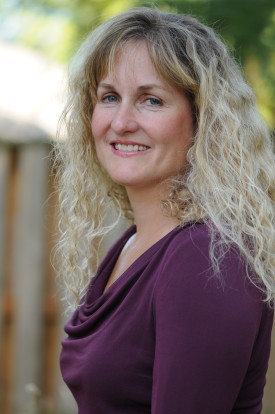 Cathy Lamb: Tell us about your story in Beach Season
Cathy Lamb: Tell us about your story in Beach Season
My story, June’s Lace, is about a woman named June MacKenzie. She grew up hippie – like with a vagabond family that traveled all over Mexico and the states with various pets. It was a happy, non-traditional, free childhood complete with tie – dyed shirts, bare feet, and a VW bus.
At complete odds with her nomadic upbringing, June later became…sigh…an attorney. She hated it.
After quitting her soul-smashing job, she became a designer of unique wedding dresses, which is ironic, as she is in the middle of a chaotic divorce and vows that she will never, ever wear a wedding dress again.
At the beach, in a blue cottage over looking the waves, with two hilarious co-workers, she strives to find peace again, and herself, if possible.
Peace comes in the form of a country song singing cowboy…
What are three things you love about being a writer and three things that are a challenge?
I love telling stories. I love daydreaming, which leads to the stories. I love writing. Three challenges? It’s a tough business. The social media part can be time consuming. When I’m on a deadline which, for me, is three months before a book is due, I look like hell, work all the time, and forget to wash my hair. Other than that, I love it!
What are the plusses of writing a short story versus a novel?
I love writing short stories for anthologies. Don’t tell anyone, but if I could do this year round, all the time, I would. I love how tight they are. How focused. I love the romantic piece of it and how they end happy. I love how you can develop quirky characters, different plot lines, angst and difficulties and challenges, but the focus is on the relationship between the man and the woman – imperfect and exciting and passionate and painful, all at the same time.
What do you like about writing romantic scenes, or creating romantic tension, in your books?
Can I say I like to live vicariously through my characters and get away with it? (Don’t tell my husband – of 22 years !! – that I said that!)
Thank you, Cathy!
Oh, you’re welcome! Thanks to myself for interviewing me!
CathyLamb.org
Email [email protected]
Facebook https://www.facebook.com/cathy.lamb.9
June 4, 2015
Beach Season, A Summery Romantic Anthology, Re – Released
Hello everyone,
Need a beach read? Our anthology, Beach Season, is being re – released today.
My story is titled “June’s Lace.” June is a wedding dress designer who lives on a cliff above the Oregon coast. Her dresses are wild, creative, works of fabric art for brides who want original fashion. June WAS married, she WAS an attorney, didn’t like either one, threw both out, and re – started her life. Her family is filled with ex hippies, her life filled with work and the rhythm of the ocean...and the tunes from the smokin’ hot country song writer who just moved in next door. Too bad she’ll never agree to getting married – trapped – again.
$5.84 on kindle. $6.47 paperback
Chapter One
Ten Things I’m Worried About:
Too many wedding dresses
Not enough wedding dresses
Grayson
Going broke
Losing my home
Never finding an unbroken, black butterfly shell
The upcoming interview with the fashion writer.
Not having peppermint sticks in my life
Turning back into the person I used to be
Always being worried
Chapter Two
“No. Absolutely not.” I gripped the phone with white knuckles as I paced around my yellow studio. “I will never agree to that.”
“Ha. I knew you wouldn’t accept those unacceptable terms, June,” Cherie Poitras, my divorce attorney, cackled. “Your soon – to – be – ex – husband has a monstrous addiction to being a jerk but don’t worry, we’re not quitting. Quitting causes my hot flashes to flare.”
“I don’t want your hot flashes to flare, Cherie. And I’m not quitting, either. I can’t.” I yanked open the French doors to my second story deck as lightning zigged and zagged across the night sky through the bubbling, black clouds, the waves of the Pacific Ocean crashing down the hill from my blue cottage.
“If I could be a lightning strike, I’d pitch it as him.”
“It would be thrilling to see that,” Cherie declared. “So vengefully Mother Nature – ish.”
“What a rat.” I shut the doors with a bang, then thought of my other life, the life before this one, and shuddered. I could not go back to it, and I was working as hard as I could to ensure that that wouldn’t happen. There wasn’t enough silk and satin in that other life. There wasn’t any kindness, either. Or softness. “I so want this to end.”
**** Previous cover
May 4, 2015
USA TODAY: It’s Not About The Sex, It’s About The Stud
HAPPY EVER AFTER
Special for USA TODAY 12:03 a.m. EDT May 4, 2015
Cathy Lamb, author of What I Remember Most and the upcoming My Very Best Friend (August), shares why she loves writing the romance scenes in her women’s fiction books.
Cathy: It’s not about the sex, it’s about the stud.
That sounds a bit crude.
But there’s truth to it. I have read many romance novels, and the love scenes, to me, aren’t about the rollicking sex, they’re about the man the woman’s rollicking around with.
I started reading romance novels when I was a teenager. You would have been hard-pressed to find a more gawky, awkward girl. My hair frizzed like I had a small light socket implanted in my head, I was bony thin, rather skeletal, and was generally baffled about life and why I was here.
But in the romance novels I read, there were true men. They were manly. Smart. Protective. Chivalrous.
Surely I’d find a man like that one day? My young heart pitter-pattered.
 I later took my love of category romance novels and tried to write them. Rejection, rejection, rejection. For years. After a particularly brutal rejection, I gave up and changed tracks.
I later took my love of category romance novels and tried to write them. Rejection, rejection, rejection. For years. After a particularly brutal rejection, I gave up and changed tracks.
I wrote a novel titled Julia’s Chocolates. It was about a woman named Julia who, in the first scene, threw her poofy wedding dress into a dead tree on a deserted street in North Dakota. She swore and cried. It came down on her head.
Julia had an Aunt Lydia who painted her home on a farm in Oregon pink, like a certain body part, and the door black to ward off seedy men. Lydia had five-foot-tall cement pigs in her front yard, each named after a man she didn’t like. Lara, another character, a minister’s wife, was a closet artist, who felt that her life was smothering her. Katie was a mother and married to an alcoholic.
I wrote about real problems that real women deal with in that book. But, I added a stud. A respectful, interesting, smokin’ hot gentleman.
It was women’s fiction, with a twist of romance. It sold. I’ve been writing women’s fiction ever since and am now writing my 10th novel.
 In my novels I’ve addressed all kinds of issues: Abuse. Schizophrenia. Addictions. Loneliness. Despair. Stalker boyfriends. An insane asylum.
In my novels I’ve addressed all kinds of issues: Abuse. Schizophrenia. Addictions. Loneliness. Despair. Stalker boyfriends. An insane asylum.
I’ve also written about a woman who ran naked along a river to get rid of her anger, another who turned a garden hose on in her cheating ex-husband’s Corvette, and a third who secretly made gigantic, colorful chairs in her garage with wings and feet. One of my characters spied on a man with night-vision goggles and laughed so hard she wet her pants.
Heartbreak and laughter, all mixed up. My characters may be broken, but they’re independent, strong-willed, like their lipstick, and they’re going to, eventually, come up swinging.
Romance has danced through most of their story lines. The truth is, I love to write the romance scenes, the tension, the conflict, the hee haw. It simmers and sparkles. Sometimes the woman is ready to jump into the man’s arms and ride off on a motorcycle, hands waving in the air. Other times she’s too troubled to get involved with anyone and she has to work through that troublesome part.
Like real life. Sometimes we can jump, sometimes we want to run. Why? Because we know that romance does not come perfect. In fact, often we have to wander around in the dark and the fog, shooting Cupid’s arrows, before we hit the right person and find the right, forever romance.
I’ve been married for 22 years. If I were to say that every day was bliss, you would know that I was lying like a son of a gun or had been slugging straight shots. I’m not lying and I don’t do straight shots.
There have been beautiful times, and there have been times that had my husband said he wanted to go and study penguins in Antarctica, I would have packed his bag and suggested he try snorkeling while there.
 Romance, for us, simmers on high now and then, and it sparkles now and then, but mostly it’s being together. It’s movie night. Or a drive to the river. Omelets.
Romance, for us, simmers on high now and then, and it sparkles now and then, but mostly it’s being together. It’s movie night. Or a drive to the river. Omelets.
It’s holding each other’s hand when all four of our parents became terminally ill. It’s holding each other’s hand as their coffins were lowered into the ground. It’s weathering job losses and being poor when we were younger, and raising teenagers, who aren’t known for being easy.
It’s worrying together and crying together and laughing with gusto.
It’s enduring. It’s a mess. It’s faithful. It’s hard. It’s funny, loving, true.
Now that’s sexy.
And romantic.
And worth writing about.
Find out more about Cathy and her books at cathylamb.org.
1
April 30, 2015
Author To Author Interview: Kristy Woodson Harvey
Cathy Lamb: Pretend you’re in North Carolina, in summer, in front of a tough, blunt, poor young woman who has made a choice most of us would find impossible.
Now, read this paragraph, then I’ll chat with you about Kristy Woodson Harvey, the author behind this intriguing debut novel titled, Dear Carolina.
 Parsnips and salsify is the only vegetables that you ought to just leave alone. They’re tough as nails, and it don’t matter how cold it is. My daddy, he used to call me his little parsnip. But I’d bet dollars to doughnuts he didn’t get the comparison. A momma who didn’t want me, always scraping by. I could survive damn near anything. But, coming up, I didn’t know we were poor. All them rich kids got packed up and sent off to private school. In a room chock full a’ free lunch cards, that dollar I took may as well have been a gold metal…
Parsnips and salsify is the only vegetables that you ought to just leave alone. They’re tough as nails, and it don’t matter how cold it is. My daddy, he used to call me his little parsnip. But I’d bet dollars to doughnuts he didn’t get the comparison. A momma who didn’t want me, always scraping by. I could survive damn near anything. But, coming up, I didn’t know we were poor. All them rich kids got packed up and sent off to private school. In a room chock full a’ free lunch cards, that dollar I took may as well have been a gold metal…
Now that is great writing. Voice, originality, pain, desperation, and strength, all in one.
Kristy, thanks for joining me today. If I told you that I would give you a mongo – sized box of chocolates if you could sum up Dear Carolina in just one sentence, what would you say?
Kristy Woodson Harvey: Dear Carolina is a book about the ways in which we create our families. (I will do ANYTHING for chocolate. Seriously.)
Cathy Lamb: Ah, a writer after my own chocolate heart. I so understand you.
I found the premise of Dear Carolina – two mothers, the birth and adoptive mother – writing letters to their baby, Carolina, fascinating and original. What was the spark that led to this idea?
When my son was first born, I remember having this moment where I was just staring at him, and we felt so connected that I couldn’t imagine giving up my child, and I wondered what would have to happen in your life for you to be able to do that. And, on the flip side, what it would be like to adopt a baby knowing that he or she would always have this deep, biological connection to another woman. And what I really, really wondered is how it would be to tackle all of these issues within a very open family adoption.
Jodi and Khaki were just in my head that night. I remember lying in bed and hearing Jodi’s voice and playing out conversations in my head. And that was it! I knew I had to write this story.
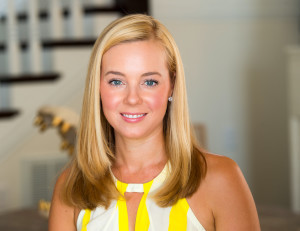 It’s amazing, the ideas that come to us in the middle of the night, isn’t it? My characters can trigger my insomnia and keep me up for hours.
It’s amazing, the ideas that come to us in the middle of the night, isn’t it? My characters can trigger my insomnia and keep me up for hours.
You’re an interior designer and live in North Carolina as is your character, Khaki. Is Khaki you? How are you the same, how are you different?
I wouldn’t say Khaki is me. But we do have similarities. I have endometriosis and did all the Chinese medicine stuff, so a good bit of that is real. Although, against all odds and what I had been told forever, I got pregnant with no trouble at all! I have my feisty moments, like Khaki, but I think she’s a little more controlling than I am. (I hope!) And she’s braver, for sure. But a lot of her juggling and decision making throughout the book was similar to things that I was going through.
And she has some real wounds that have shaped her and a very tough momma who also made her who she is. I have the sweetest, best mom in the world and no real tragedies, which I am very, very thankful for!
One thing I so enjoyed in the book was how completely, utterly different the two voices of Khaki and Jodi were. That is much harder to pull off than it looks, as you know. Please include one favorite line/paragraph from each of them that you feel best sums up their personalities.
I don’t know if these sum up their personalities, but I love when Jodi says, “The only thing that can really be changed is a dollar bill.” She’s quick and so cute, and she has so much wisdom for a nineteen-year-old. But, even though she’s been through so much, there’s such a vulnerability about her, too. It’s like she understands the harshness of life but she hasn’t let it make her jaded.
For Khaki, “You can never have too many people who love you,” sums it up, for sure. She has some wounds herself, and the way she heals them is by surrounding herself with love. I think she makes some very, very difficult decisions in this book that aren’t necessarily best for her out of her big heart. She can be kind of annoying and over-bearing at times. But she does it with such good intentions.
 You have covered many issues in this book. Alcoholism, widowhood, single motherhood, abuse, a restraining order, adoption, the consideration of an abortion, marriage, infertility. Why were all of these topics important for you to address?
You have covered many issues in this book. Alcoholism, widowhood, single motherhood, abuse, a restraining order, adoption, the consideration of an abortion, marriage, infertility. Why were all of these topics important for you to address?
This may sound silly but, to be honest, I didn’t really set out to address any issues. I just had the idea for the book and this is how it unfolded. I think all of these things are issues that real women are grappling with day in and day out. But this book was one hundred percent driven by the characters, not the issues.
What part did your Christian faith play in writing this novel and in the characters and their character arcs?
My faith is very important to me, but I didn’t really set out to include that in the book. (In fact, my work in progress really has none of that.) This was a very Southern story, and I think Christianity is something sort of ingrained and intrinsic to this culture and, in particular, these characters. It almost felt like I couldn’t tell the story without a little faith woven in because they would have been raised with that as such a critical part of their lives.
This is your first book. (Whooee!) What did you learn during this process? What advice would you give new writers? Are you working on another book?
Getting your first book deal is a bit like jumping into the deep end before your first swimming lesson. It has been fun and amazing and trying at times. But so, so gratifying. A dream come true! I learned patience at a level I have never known, for sure. So my advice to new writers is to submit when you can, know you’re going to wait a long time, and keep writing. It makes the waiting so much easier. And then, if you get a big stack of rejections back, you have a brand new book to submit.
My next book, LIES AND OTHER ACTS OF LOVE, is coming out April 2016. I’m about halfway through my third book, but I haven’t been working on it much with the launch of DEAR CAROLINA. I can’t wait to dive back in.
Can you describe for us your writing process? Do you write a first draft and then edit multiple times, or do you edit as you go? Do you ever feel like banging your head against the wall when you’re writing?
I always start the book with a scene that won’t let me go. For DEAR CAROLINA, it was the scene where Jodi is on the beach, deciding whether to give up Carolina, the cover scene, actually. I write those really critical scenes that are in my head and then weave the story around those. I try to write a first draft fairly quickly and then I edit and edit and edit, put it away for a couple of months, come back and edit again. I value my writing time so incredibly much because, as a stay-at-home mom, I don’t get it as regularly as I would like. So, usually, I’m ready to jump in.
Some days, I muddle through those 2,000 words and think they are terrible. But, funnily enough, I tend to come back to those passages where it felt like pulling teeth later and think they are great. Weird, right?
Well, there’s a lot that is “weird” about writing, that’s for sure. I can go on and on about that very topic, but I won’t.
We’ve jumped ahead a little bit, but it’s not too late. Tell us about you, especially your adorable three year old. What is a normal day like for you, when do you write, when do you work, what do you like to do, etc.
I think a “normal” day might be a bit of a stretch! Hahaha! He’s in preschool four mornings a week so, ideally, I drop him off at school, write my 2,000 words while he’s there, and hopefully get some emails answered. After he goes to bed, I do my design blog, author blog, freelance work etc. I help my husband a bit at his dental office so sometimes my little guy gets to come do that with me. It’s not always pretty, but it usually tends to work out.
We spend pretty much every weekend at the beach, and I always try to get some writing time in while Daddy is on duty. I love hanging out with those boys and always try to get my girls’ nights in too. I got my yoga certification a few years ago, so I try to fit a bit of that in there, too. This has been a very, very fun and happy time in my life, and I know I will always look back on these years as some of the best.
I just have to ask this, as I’m curious and am not good at decorating: As an interior designer, can you give us five To Do Tips For Decorating and Five Don’t Do Tips For Decorating?
I don’t believe that one bit. You couldn’t have written Grenady without being a good decorator! But, all the same, here’s my two cents:
To do:
1. Buy things you love.
2. Pick out rooms you like in magazines, on Pinterest, etc. to help give you a clear vision of what you want.
3. When in doubt, start with art. One focal point can totally make a room.
4. Buy the best furniture you can afford and keep it for years.
5. If you aren’t sure of your “look,” buy your major pieces in neutral fabrics and change up the pillows and accessories with your mood.
Don’t:
1. Buy furniture without measuring first. Scale is so important and the wrong scale can ruin the look of a room.
2. Decorate with trends. Nothing is timeless, so you’ll probably have to refresh your look every few years, but you don’t want to buy furniture that you like for a season only to have to turn around and do it all over again.
3. Be in such a rush to get it all done that you sacrifice what you really want for convenience.
4. Buy anything that you don’t love. Period. If you don’t love it, it doesn’t have a place in your home.
5. Forget to let your personality shine through. Your home should be a reflection of your family.
Visit with Kristy on her website http://www.kristywoodsonharvey.com/
Facebook https://www.facebook.com/profile.php?...
To buy Dear Carolina…
BARNES AND NOBLE | INDIEBOUND | BOOKS A MILLION | AMAZON | POWELLS | TARGET | iTUNES | GOOGLE PLAY | KOBO
April 22, 2015
A Heart Brownie – Calorie Releaser
You do know that if you cut a heart in the center of a pan of brownies, the heart lovingly releases all the calories into the air, right?
This is why I was able to eat four brownies, extra chocolate chips. This trick is how I keep my girlish figure. (That is a JOKE for those of you who have not met me, by the way. We’ll just politely say that I CURVE.)
April 20, 2015
For Writers: Old Homes With Secrets, Car Living, and Scottish Men in Kilts. How To Create Compelling Settings In Your Books.
I don’t like boring words.
I like scintillating words. Words that are skippy and delicious, or long with multiple syllables that roll like literary candy out of your mouth. Words that make you think, words that sound like what they are, words that dance and tease and have hidden meanings.
I do not like this word: Setting.
Setting.
So boring. Lifeless. No romance to it. No high jinks. No dynamite.
And yet.
 As a writer, the setting is so important in a book. The setting can increase the tension and the conflict, transport the reader to paradise or to terror, and ratchet up the odds, the mystery, the romance or the thrill ride.
As a writer, the setting is so important in a book. The setting can increase the tension and the conflict, transport the reader to paradise or to terror, and ratchet up the odds, the mystery, the romance or the thrill ride.
Here are a few thoughts on setting, from my fried writer brain to yours. I apologize for using my books as examples all the way through, but hey. I know my books best and I know why I used that setting as I did, so hopefully it will be helpful.
1. Use setting to heighten a difficult personal struggle and make life even more challenging for your character.
In my latest book, What I Remember Most, the primary setting is a small, western style town in central Oregon surrounded by snow capped mountains. You can almost taste the snowflakes on your tongue and see sexy cowboys galloping by on horses.
But within that setting, my protagonist, Grenadine Scotch Wild, is living in her car. Yes, her car. On the run, away from a husband who has been arrested for embezzlement, fraud, and money laundering and will not tell the officials she’s innocent unless she returns to him. Grenadine’s accounts have been frozen by the government, she’s dead broke, therefore, car living.
 Do you have a vision of car living? If not, go and park in your car in a parking lot and sit there for three hours. Stuffy. Hot. Uncomfortable. How do you sleep? Dangerous. Where do you pee? Yes, that. What a problem.
Do you have a vision of car living? If not, go and park in your car in a parking lot and sit there for three hours. Stuffy. Hot. Uncomfortable. How do you sleep? Dangerous. Where do you pee? Yes, that. What a problem.
The setting worked because no one wants to live in a car and the readers were rooting for Grenadine to get out of it. She was a sympathetic character, a woman who had lost everything, a woman who was fighting to get out of car living, a woman who was working hard, had no help, and was one her own. And oh, a jail sentence hanging over her head.
Use setting to toss your character into chaos.
2. Make your reader shudder. Your setting can be used for tension, horror, angst, crimes. Take them to a place they DON’T want to go. Ever. Make them uncomfortable. Make them catch their breath.
I put Grenadine in jail for the weekend. I went to jail for three hours on a tour so I could get it right. Think: Suffocating. Bars. Scary people. Violence. Group showers. Horrible food and who looks good in a blue jumpsuit?
In The First Day Of The Rest Of My Life, I created a small, dusty, cramped house in the middle of nowhere for a crime to take place. The setting scared me, and I wrote it.
I had an insane asylum in Such A Pretty Face, briefly, where the mother was committed.
Settings can illuminate the plight of your characters, their internal hell and their external challenges.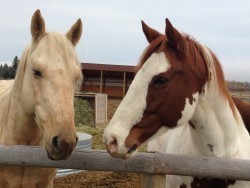 3. Make your reader gleeful. Let your reader live vicariously through your characters in their setting.
3. Make your reader gleeful. Let your reader live vicariously through your characters in their setting.
Later, after working as a bartender and as an assistant to a furniture maker, two exhausting jobs, Grenadine finally got enough money together to rent a place.
So what setting did I put her in next? A cozy remodeled apartment above a red barn in the country.
I described the two decks overlooking the farmland, the magnificent sunset and sunrise views, the animals she sees, the peace and tranquility.
Why this setting? I would love to live atop a barn, horses below, in the country. Many of my readers would, too.
In the book I just finished, My Very Best Friend, which almost made me want to go and live in a cabin, alone, in Montana, and mutter to myself, but that is another story, I set it in Scotland. Imagine: Hot Scotsmen in kilts. Bagpipes. Green rolling hills. Charming villages. Who wouldn’t want to go to Scotland?
Imagine: Hot Scotsmen in kilts. Bagpipes. Green rolling hills. Charming villages. Who wouldn’t want to go to Scotland?
I’ve also set stories on quaint islands, Oregon beach towns, a town along a river, a schoolhouse transformed into a home, Cape Cod, a lavender farm, a tree house, and a Queen Anne house.
Take your reader on a trip with you. They want to go. Their bags are packed and ready.
4. Tap your readers’ inner most imaginations.
In Julia’s Chocolates, Lara is a closet painter. I gave her an attic, then described all the wild, free wheeling paintings in there.
In Such A Pretty Face, Stevie had a garage where she built and painted chairs – huge chairs, with feet and wings and stripes and polka dots.
Grenadine is a collage artist and painter. I gave her a studio in the top floor of her little green house. I described the colorful tables and chairs, the jars full of paints, sequins, fabrics, brushes, lace, etc. The books on art, the plants, the windows. Being an artist appeals to readers, to their dreams.
Build settings that encourage your readers to think, to be inspired, to dream. What if…what if I started painting again? Building again? Writing? Making a collage?
5. Relate to your readers’ real lives with your setting.
In A Different Kind Of Normal I created a home that belonged to my character’s ancestors. There washistory in that house. Jaden was walking up the same stairs as her ancestors, looking out the same windows, crying at her kitchen table, which her ancestors had probably cried at, too.  Your readers have homes they love and miss, homes that have prickly memories. They have grandparents, crazy aunts, beloved dead fathers, too. They have Godzilla–type ex spouses and distracted boyfriends. They have funny pets. They have jobs and bosses they hate in the corporate world. They go to family reunions at the lake and take tranquilizers while they’re there.
Your readers have homes they love and miss, homes that have prickly memories. They have grandparents, crazy aunts, beloved dead fathers, too. They have Godzilla–type ex spouses and distracted boyfriends. They have funny pets. They have jobs and bosses they hate in the corporate world. They go to family reunions at the lake and take tranquilizers while they’re there.
They have failing businesses and cliques they have to deal with in the suburbs.
Link your readers’ personal lives to the setting in your story, which will make your book more relatable, and personal, to them.
6. Know your readers. What do many of them like? Use it.
I think my women readers like lingerie. It’s frilly. Pretty. It inspires passion. So in If You Could See What I See, Meggie had a lingerie company, filled with silk and lace.
In The Last Time I Was Me, Jeanne Stewart gutted and remodeled a dilapidated house. I think my readers like reading about remodeling and décor, new kitchens and paint colors. They have homes, too.
In Henry’s Sisters, the sisters were running a bakery. Giant cupcakes, wedding cakes, delicious treats. Yes, I think my readers like bakeries and sweets.
Appeal to your reader via your setting.
 7. Make your setting something that readers can laugh about.
7. Make your setting something that readers can laugh about.
In Julia’s Chocolates, Julia is out on her Aunt Lydia’s farm. Aunt Lydia has tons of chickens. Chickens in brightly painted chicken coops, chickens who chase each other, chickens who have quirky personalities. And the roosters, those dandy fellows!
Aunt Lydia also has a rainbow bridge in her front yard, toilets overflowing with flowers, and four foot tall ceramic pigs who each have a nametag. The pigs are named after men Aunt Lydia doesn’t like.
Her front door is painted black to “ward off seedy men.”
Funny, right? Good. Readers like to laugh.
To sum up this huge essay, which I did not intend to be quite so long, write your settings to evoke memories, emotions, thoughts, tears, laughter, etc. from your readers. You want them to feel. You want them to think. You want them to block everything else out of their life and dive head first into your story.
Use the setting in your books to help them do so.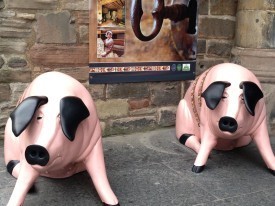 There is so much more to say about setting, how to use weather, charging rivers, frothing oceans, seasons, evocative or dangerous landscapes, bleak neighborhoods and destitute countries, etc. but that is enough for today. I have to start writing my new book now, if I can get my brain to work.
There is so much more to say about setting, how to use weather, charging rivers, frothing oceans, seasons, evocative or dangerous landscapes, bleak neighborhoods and destitute countries, etc. but that is enough for today. I have to start writing my new book now, if I can get my brain to work.
I do know the setting, though. It’s a tugboat on a river, complete with ducks who lay eggs in pots on the deck, a blue heron, geese, sailboats, and odd ball neighbors. Including a secretive man who lives two houseboats down…
*** originally published in Velvet Morning Press http://velvetmorningpress.blogspot.com/
April 10, 2015
A Little Heart…
April 1, 2015
Author To Author Interview: Andrea Lochen
Today I’m interviewing author Andrea Lochen, a new mother and a great writer with a truly stunning imagination.
So, Andrea, before we dive into that imagination of yours, I’m as curious as everyone else is about authors and their lives. Tell us about yourself.
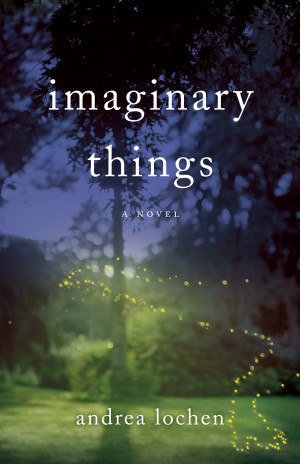 Andrea Lochen: I’m the author of two novels, Imaginary Things and The Repeat Year, both of which are a unique blend of women’s fiction and magical realism. I like to write about ordinary people living in otherwise ordinary settings who encounter extraordinary opportunities (Such as seeing your child’s imaginary friends or reliving a year of your life, respectively.)
Andrea Lochen: I’m the author of two novels, Imaginary Things and The Repeat Year, both of which are a unique blend of women’s fiction and magical realism. I like to write about ordinary people living in otherwise ordinary settings who encounter extraordinary opportunities (Such as seeing your child’s imaginary friends or reliving a year of your life, respectively.)
Nine months out of the year, I’m also an English lecturer at the University of Wisconsin-Waukesha where I teach writing to undergraduate students. I live in Madison, Wisconsin with my husband, my two-month old daughter, and my Teddy Bear dog (an adorably fluffy Bichon Shih Tzu mix).
In my free time, I’m an avid reader and baker (cupcakes with butter cream frosting are my specialty!)
Cathy Lamb: Lovely. Now I have something to look forward to when I see the postman. I love butter cream icing!
But on another note that is not about scrumptious cupcakes, in your book, Imaginary Things, Anna Jennings can see her son’s imagination. I absolutely love that.
What was the spark?
I was a very imaginative child, and though I never had an imaginary friend, my older sister and I loved to play these very involved games of make believe. Some of our favorites were orphanage, the Box Car children (Yes, we were very into orphans, apparently!) school, and gift shop.
I remember sometimes getting so involved in these elaborate scenarios that our little fantasy worlds would actually feel real to us, so imagination has always been something that preoccupies and fascinates me. When starting a new writing project, I tend to use a “what if?” question as my jumping off point.
For Imaginary Things, that question was: what if a parent had the ability to see their child’s inner life of pretend play? And voila! Anna and David were born.
I loved the first paragraph of your book because it sounded true. “There was something about driving an ancient Dodge Caravan packed with all of my worldly possessions, including my four year old son and my cat, that reeked of failure and desperation.”
Have you ever been in a situation like this yourself?
Thankfully I’ve never been in a situation quite as dire as Anna’s (one that financially requires her to move herself and her son in with her grandparents), but I certainly have had more than my share of do-it-yourself moves, cross-country (from Mississippi to Michigan, for example) and otherwise.
Packing up all of your belongings into a car and hauling them across state lines really makes your life seem small and portable in a way that I find disconcerting. It also requires you to sort through your personal possessions, as well as the memories attached to them, and decide what to keep and what to cast off.
And it’s always a little unnerving starting over in a new place, which is the off-kilter feeling I wanted Anna to have at the beginning of the book.
What part of yourself, or your life, is in the character of Anna Jennings? Authors often share, in one way or another, what they think, how they feel, and their past, etc. through their characters. Did you do that here?
Anna and I are actually more different than similar. I put a lot more of myself into the protagonist from my first novel, Olive Watson (who is more reasonable and tends to play it safe), so when I started Imaginary Things, I knew I wanted to break away from that and write someone who was a little more reckless and impulsive.
That was one of the reasons I chose to write this book using a first-person point of view rather than third-person; it was easier for me to get into Anna’s perspective if I was also in her distinctive voice.
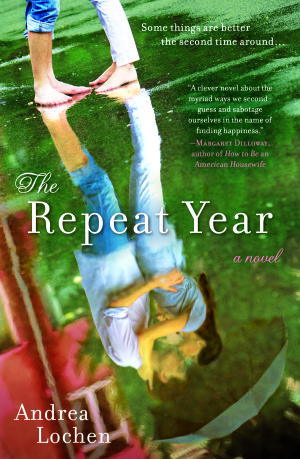 What’s interesting to a lot of readers is that I wrote this novel about a mother and child relationship a few years before I actually became a mother. But the tender scenes between Anna and David were some of my favorite to imagine and write.
What’s interesting to a lot of readers is that I wrote this novel about a mother and child relationship a few years before I actually became a mother. But the tender scenes between Anna and David were some of my favorite to imagine and write.
And though I don’t have the magical ability to see my daughter’s imagination (although, who knows? She’s currently much too young for that kind of play!), I feel like Anna and I both share an incredibly fierce love for our children.
Aw, we mothers. I totally understand both you and Anna. The love we have for our kids is endless, isn’t it?
But mother to mother and author to author, what was the hardest part about writing this book?
Figuring out why Anna could see David’s imagination and what it all meant. So as she is struggling to figure out the rules of this bizarre phenomenon and what it all adds up to in the novel’s action, I, as the author, was as well! My writing process tends to be a kind of puzzle-solving that requires me to work backwards.
Oh, that is so interesting. I have a general idea of where I’m going in the story, but things shift and change while I write. I often take out characters in my fourth or fifth edit. I think of writing as a puzzle, too, only sometimes the puzzle is head bangingly difficult and it seems like I can’t find the right pieces.
How long did it take you to write Imaginary Things? How many times did you edit it?
Imaginary Things began as a short story I started writing back in 2006 which eventually morphed into a novel. So if you count that as my starting point, eight years? (Gulp!) Of course, I wasn’t actively working on it that entire time since I was focusing most of my attention on my first novel, The Repeat Year. But once The Repeat Year was published in 2013, I returned my attention to David and his dinosaurs.
I’m a really fast drafter and a terribly slow (and kind of whiny!) reviser. I think it took me about eight drafts and some very helpful feedback from my trusted readers to finally get it right.
What challenges do you face as a writer? What do you love about it?
Finding time, of course, but I know that’s also kind of an excuse! As I mentioned above, I absolutely love the creative process of drafting—inventing new characters, concocting dialogue, weaving plot, describing settings, and the joyful sense of discovery. Revision is much more challenging for me, because it feels more like work than play, but I’m gradually getting better at it.
How long have you been teaching at UW – Waukesha? What are three most important pieces of writing advice you have for your students?
I’ve been teaching at UW-Waukesha for the past six and a half years, and I love it! It’s really invigorating working with young writers and it helps remind me of the passion, enthusiasm, and sense of unlimited possibility that all authors should strive to keep alive in their writing.
I advise my students to 1) Never start a story with a character’s alarm clock going off and starting their day, but rather start as close to the action as possible. 2) Learn “the rules” of writing in order to be able to consciously break the rules, and 3) Persevere, persevere, persevere!
I always tell them that the only difference between the amateur writers and the professionals is not talent, but hard work, belief in oneself, and the ability to revise.
What is your goal as a novelist?
To, in some small way, improve the lives of my readers, whether that is through recognition of themselves and their struggles in my characters or just pure entertainment and enjoyment!
If you had a whole day to yourself, what would you do?
As a new mom with a two-month-old daughter, I immediately knew my answer to this question! SLEEP! In a darkened room with a fluffy down comforter and gentle white noise in the background and no alarms or cries to wake me. Just deep, uninterrupted sleep for as long as my body desires! Then once I woke up (if I had any time left!), I would maybe get a massage or pedicure and do some long overdue clothes shopping with a friend.
Thanks for your time, Andrea, and for letting us peek into that imagination of yours.
Andrea’s website: http://andrealochen.com/
Facebook page: https://www.facebook.com/andrealochen...
Amazon link to purchase IMAGINARY THINGS: http://www.amazon.com/Imaginary-Thing...
March 27, 2015
Putting Glasses On My Cat
My poor cat. You know you have WAY too much time on your hands when you spend ten minutes putting your glasses on your cat’s face – just so – and then taking a picture.
That’s Innocent Husband in the background. We are getting old and are easily entertained.
March 22, 2015
Author To Author Interview: Adria J. Cimino
Bonjour, Adria!
I want to chat with you about your novels and publishing business, but I can’t resist asking about your life in Paris, France first. You were born here in America, and yet now you’re in the City of Lights. I think I want to be you! Tell us about that journey.
 Hi Cathy, Thanks for inviting me to your blog! Like so many American students, I took French in school and dreamed of one day living in Paris. As it turned out, I enjoyed the language so much that I continued it through college, and through this interest, ended up meeting a lot of French expats in my hometown of Sarasota, Fl.
Hi Cathy, Thanks for inviting me to your blog! Like so many American students, I took French in school and dreamed of one day living in Paris. As it turned out, I enjoyed the language so much that I continued it through college, and through this interest, ended up meeting a lot of French expats in my hometown of Sarasota, Fl.
One of these friends helped me plan a trip to France to improve my French, and introduced me to a young man who could show me around Paris. He used to be her neighbor when she lived in France, and he was a college student, too. As they say, the rest is history! We got married couple of years later, spent a few years in the U.S. and then returned to Paris—where I’d always wanted to live!
I love it. You are living a love story. We should make a movie about your life. You write the script.
Speaking of writing, you have three books Close To Destiny, Paris Rue Des Martyrs, and That’s Paris. Can you give us a couple of sentences about each book?
Close to Destiny is a magical realism novel about righting the wrongs of the past. A young woman facing inner demons is plagued by strange encounters at a London hotel. The experiences make her question her own notion of reality—and the power she holds over her own destiny.
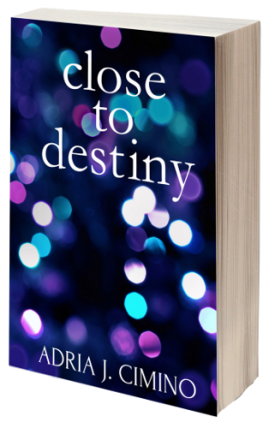 Paris, Rue des Martyrs, contemporary fiction, is about encounters that make a difference. Four strangers in Paris are at a moment of crisis in their lives. And at that moment, their stories entwine as their paths cross on this typically Parisian street—the Rue des Martyrs.
Paris, Rue des Martyrs, contemporary fiction, is about encounters that make a difference. Four strangers in Paris are at a moment of crisis in their lives. And at that moment, their stories entwine as their paths cross on this typically Parisian street—the Rue des Martyrs.
That’s Paris is a multi-author short story anthology, with a foreword by best-selling author Stephen Clarke (A Year in the Merde). From culinary treats (and catastrophes) to swoon-worthy romantic encounters (and heartbreaking mishaps), this anthology takes the reader on a journey through Paris—and what it’s really like to live here!
Did you always plan on becoming a writer? What other jobs and experiences have you had?
I always loved to read, and as a teenager started writing a bit, but the idea of creating an entire novel scared me. By the time I was in my early 20s though, the need to write was too great, overpowering any intimidation. And so I set to work. In the meantime, I became a journalist, writing for The Associated Press, a business journal in Boston, and finally for Bloomberg News in Paris.
That all sounds very exciting, especially from the perspective of my life here in suburbia, where the most exciting thing is listening to the coyotes howling.
What do you like about writing? How many hours a day do you write?
I love the idea, that, through my characters, I can experience many adventures. Because as I write, I feel as if I’m right there with them. In Paris, Rue des Martyrs, I “became” an aging actor, an emerald broker, a young artist and a Parisian housewife. I also enjoy the fact that there aren’t the constraints of reality—I especially appreciated this as I wrote Close to Destiny. Anything can happen! I usually write in the morning for about three hours at a time.
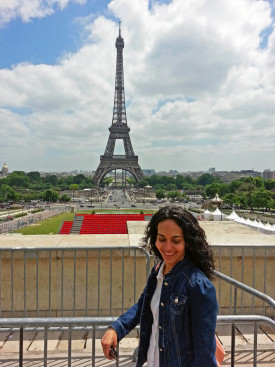 Tell us about your road to publishing. For me, it was not smooth at all. Rocky. Bumpy. Disappointing. And then, finally, the novels sold, before I started throwing things.
Tell us about your road to publishing. For me, it was not smooth at all. Rocky. Bumpy. Disappointing. And then, finally, the novels sold, before I started throwing things.
I worked as a journalist and wrote for many years in my spare time. I was rejected by some agents and then landed one. Unfortunately, he couldn’t sell Paris, Rue des Martyrs to a major publishing house and wasn’t interested in trying smaller houses. My agent started an ebook imprint so published my novel that way last year. But I wanted a different strategy. I wanted my book out in paperback, and I wanted some marketing support.
And now you own your own publishing business, Velvet Morning Press. Tell us about this change in events, though. What do you like about it, what’s a challenge?
I met self-published author Vicki Lesage, who was doing better on her own than I was with my agent. We realized that we could help each other—and probably a lot of other young writers too. So we formed Velvet Morning Press. I like the fact that we have control over the time frame for our projects.
Once a manuscript is polished, we can publish the book in four months. The biggest challenge is visibility. Since we’re small, we have to work really hard to get our name out there and show that we can produce quality books. We are grateful for the help of authors who are well-known and who have followed us on social media and promote our work.
What’s the difference between publishing with a major publishing house, self publishing, and what you offer at Velvet Morning Press?
 Like major publishing houses, we edit, do cover design and formatting, and publish our clients’ books in paperback and ebook form. And like the majors, we are selective and don’t charge authors fees. Like them, we use a royalty model. Other than our size, the main differences between the majors and us:
Like major publishing houses, we edit, do cover design and formatting, and publish our clients’ books in paperback and ebook form. And like the majors, we are selective and don’t charge authors fees. Like them, we use a royalty model. Other than our size, the main differences between the majors and us:
*We bring our books to market in about four months.
*We only accept very polished work. We will edit, but if a book really needs major rewriting, we will pass on the project.
*We don’t have a big budget like the majors, and we know that we can’t compete on that level. So we don’t. We can’t pay for advertisements in a major newspaper, but we use our creativity to market in different ways. And so far, so good.
We only work with self-published authors through our separate “author services” branch. Through that service, we offer editing, formatting etc. for a fee to authors who are not clients of our publishing house.
So far, submissions to our publishing house mainly have come from authors who are seeking to be traditionally published. I think many writers who love self-publishing continue to go down that road.
As a publisher, what are you looking for in a novel?
We look for novels that have us hooked within the first few pages. We look for engaging, interesting characters. And we look for carefully edited work. If I see that the author has made a bunch of spelling errors that are even highlighted by the computer’s spell check, to me, this seems sloppy. As a writer myself, I wouldn’t submit a manuscript like that.
 And when you’re not writing, not working on your publishing business, if there is time left over, what do you just love to do?
And when you’re not writing, not working on your publishing business, if there is time left over, what do you just love to do?
Reading, modern dance, strolling around Paris with my husband, having a “girl’s afternoon out” with my 4-year-old daughter.
Five things we must do if we visit Paris that are not your typical tourist attractions…
*The Rue des Martyrs in Montmartre (the setting of Paris, Rue des Martyrs) is now more and more on the radar screens of tourists, but it is still is a great example of a traditional Parisian neighborhood. Stop at a café and watch the world go by.
*The Promenade Plantee, in the 12th arrondissement is an elevated walkway along an old railway. Today, it’s lined with flowers, plants and trees above the hustle and bustle below. A great place for a walk!
*For fans of Hemingway, take a stroll by his old apartment at 74, Rue du Cardinal-Lemoine. And walk around the neighborhood, imaging how Hemingway must have saw it. (Things looked about the same back then as Paris doesn’t change much!)
*Take a side street, explore a neighborhood. This is where you’ll also have a chance of finding the best food—at a modest, neighborhood café that is filled with locals.
*Walk along any of the bridges at sunset and watch how the light illuminates the beautiful historic buildings, turning them golden!
Let’s let everyone take a peek as your newest book, Close to Destiny.
July 1
It was my third time. Don’t they always say things happen in
threes? Knife slitting through fragile skin, still damp.
Water pounding like giant teardrops. Sitting at the edge of the
bathtub, knees shaking, watching scarlet water flow.
Darkness. Silence.
What seemed like a second turned into eternity. Blinding light.
Voices. Madness. Silence.
That’s all I could write, all I could remember.
I didn’t want to think about it. I didn’t want to analyze the situation or understand
Another snippet…
There have been too many coincidences, too many dreams, too many feelings
leading me down the same road. I still don’t understand how Destiny knew all
that she did—about me, then and now.
About you. About everyone, it seems.
OK, she was a medium, but what does that really mean? That she had access to
the deepest secrets of everyone on the planet? Maybe it doesn’t matter, anyway. If
I’m willing to accept such an outlandish story, I guess I should be willing to
accept the mysterious nature of Destiny.
That said, I can’t continue this way.
Thanks for chatting with us, Adria!
Close to Destiny on Amazon: http://www.amazon.com/Close-Destiny-Adria-J-Cimino/dp/0692346945
Paris, Rue des Martyrs on Amazon: http://www.amazon.com/Paris-Rue-Martyrs-Adria-Cimino/dp/0692335072
That’s Paris: An Anthology of Life, Love and Sarcasm in the City of Light on Amazon: http://www.amazon.com/Thats-Paris-Anthology-Sarcasm-Light/dp/0692340114
Adria’s blog: http://adriainparis.blogspot.fr/
Adria’s Facebook page: https://www.facebook.com/AdriaJ.inParis
Adria’s Twitter handle: @Adria_in_Paris
Sign-up for Adria’s New Release Newsletter: http://eepurl.com/8y0K1

